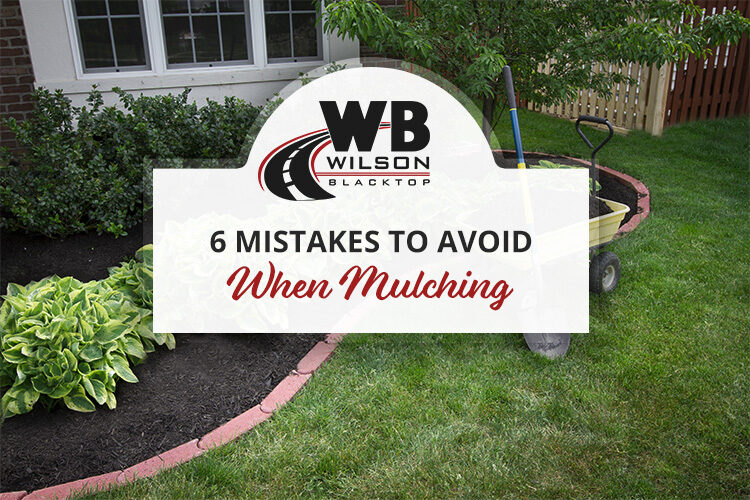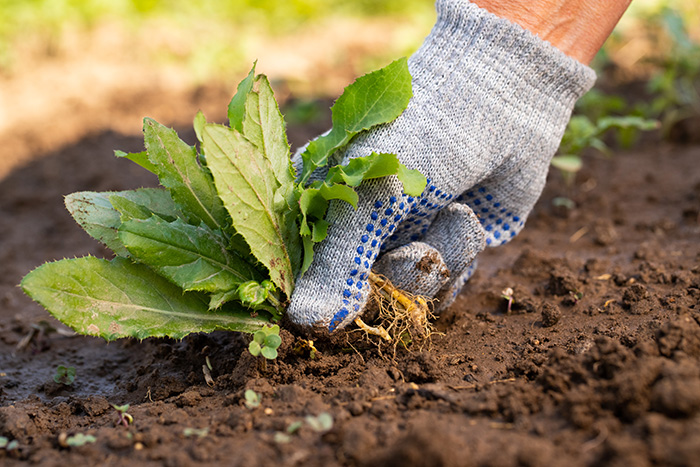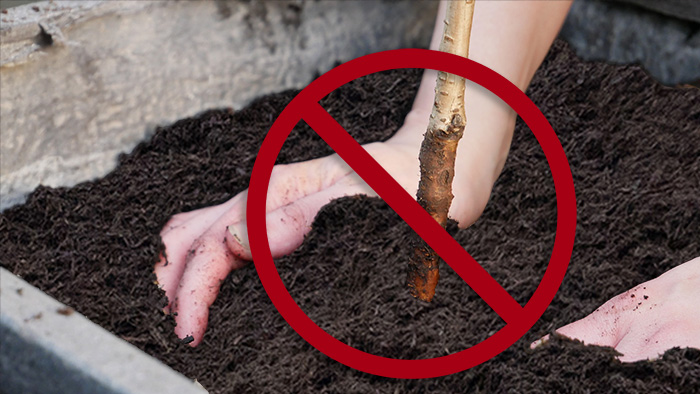
- By admin
- In Landscaping
6 Mulching Mistakes to Avoid
Ahh, spring is finally here, and you’re eager to spruce up the dull, drab winter look of your landscaping. Nothing says warm weather is here to stay like a fresh layer of gorgeous mulch in your flower beds. But what are some mulching mistakes to avoid? As it turns out, there’s a lot to understand.
Mulching trees, shrubs, and flowers can add nutrients and protect against excessive evaporation. However, if done improperly, it can do more harm than good.
Let’s look at some of the mulching mistakes to avoid:
MISTAKE 1: SPREADING MULCH TOO EARLY
Spring fever is for real. Many people feel the effects of it every year and it’s usually the root cause of mistake number 1; Spreading Mulch too Early.
The soil needs to warm up before mulching in the spring. Not allowing this natural process to complete will keep the ground cold longer which isn’t good for the plants in your landscaping. The best time to mulch is in mid-to-late spring, with a freshening up in the warm summer months to help retain moisture and insulate from the cold that will follow in the winter.
NOTE: If you reapply in the summer, be sure there is no more than 2-4 inches of mulch total, or you will do more harm than good.
MISTAKE 2: THINKING MULCH WILL KILL THE EXISTING WEEDS
The first step in laying mulch has nothing to do with the mulch. It’s all about preparation. Inexperienced landscapers mistakenly assume that mulch will snuff out the existing weeds. While that might be true of some small, weak plants, it will not eliminate well-established weeds. You must remove the weeds (preferably by the root) and then apply a preemergent weed prevention product to the ground before adding mulch.

Creeping weeds like Bermuda grass are especially problematic. You should eliminate these invaders before spreading mulch. They will happily grow along the ground, below the mulch, and then pop up wherever they can find a crack. Once your mulch bed is rid of these nuisances, add a trench or edging along the border to keep them at bay.
MISTAKE 3: USING TOO MUCH MULCH
As noted in MISTAKE 1, your mulch bed should have no more than 2-4 inches of mulch. It is a common mistake to continually add more and more mulch. Too much mulch can keep water from reaching the roots of the plants you are trying to protect. Any more than the recommended amount of mulch can lead to the roots of your trees/plants becoming shallow as they search for water. The hot, dry summer months will then take a toll on these vital feeder roots. Shallow roots can weaken the structure of trees as they need those roots to grow down into the ground to be able to withstand the cold and wind of the winter months.
NOTE: Thoroughly water the mulch after spreading it since dry mulch can absorb water away from the ground. To read more watering tips, check out Tips for Watering Your Landscaping.
MISTAKE 4: CREATING MULCH VOLCANOES
Piling mulch up around the base of a tree is known as a mulch volcano. Not only do the issues mentioned in MISTAKE 3 apply here, but there are a few others. Mulch Volcanoes can contribute to root collar rot, insects boring into the trunk, giving diseases an entry point, and even lead to rodent issues.
It is best to leave the root collar free of mulch and not allow the mulch to invade its space. The same method will benefit other plants and shrubs as well.

NOTE: While you can put mulch against a concrete foundation, allowing it to touch the wood structure or siding of your home can lead to termites and other insect infestations. Keep a 6-inch minimum gap between the mulch and any type of wood structure.
MISTAKE 5: NOT USING MULCH
The biggest mistake you can make is NOT using mulch at all. When done properly, mulching your landscape will insulate your plants’ roots from the heat of summer and the bitter cold of winter, it helps retain moisture in the ground and keeps weeds under control. Mulch also provides a buffer between your landscaping foliage and the lawnmower.
MISTAKE 6: USING CHEAP, BAGGED MULCH
Last, but not least, the mulch you choose will go a long way to determining the success of your efforts. You should not use the tree you had removed and ground it into mulch. Also, bagged mulch from the local retail store can be a breeding ground for mold, mildew, and insects.
At Wilson Blacktop, we supply disease-free, never-bagged mulch in a variety of colors to fit your style. You can choose as little or as much as you need without worry because we deliver. Give us a call today at 740.635.3566.
Armed with all this information on mulching mistakes to avoid, what are you waiting for? Get out there and beautify your outdoor living space.






3 COMMENTS
Max Jones
May 31, 2022, 8:50 pm REPLYThanks for the info about mulch. I am thinking of doing some landscaping soon. I’ll make sure to find good mulch for the landscaping.
John Carston
July 22, 2022, 2:25 am REPLYIt helped when you said that you should be aware that too much mulching could prevent the water from reaching the roots. The other day, my best friend told me that he was looking for a reliable landscape service that could help him with clearing his farming land, and he asked if I had any idea what would be the best option to consider. I like this instructive article, I’ll tell him that it will be much better if he consults a trusted mulching service as they can provide more information about the process.
Jeanene Estep
April 14, 2024, 11:09 pm REPLYThanks for the mulching tips!